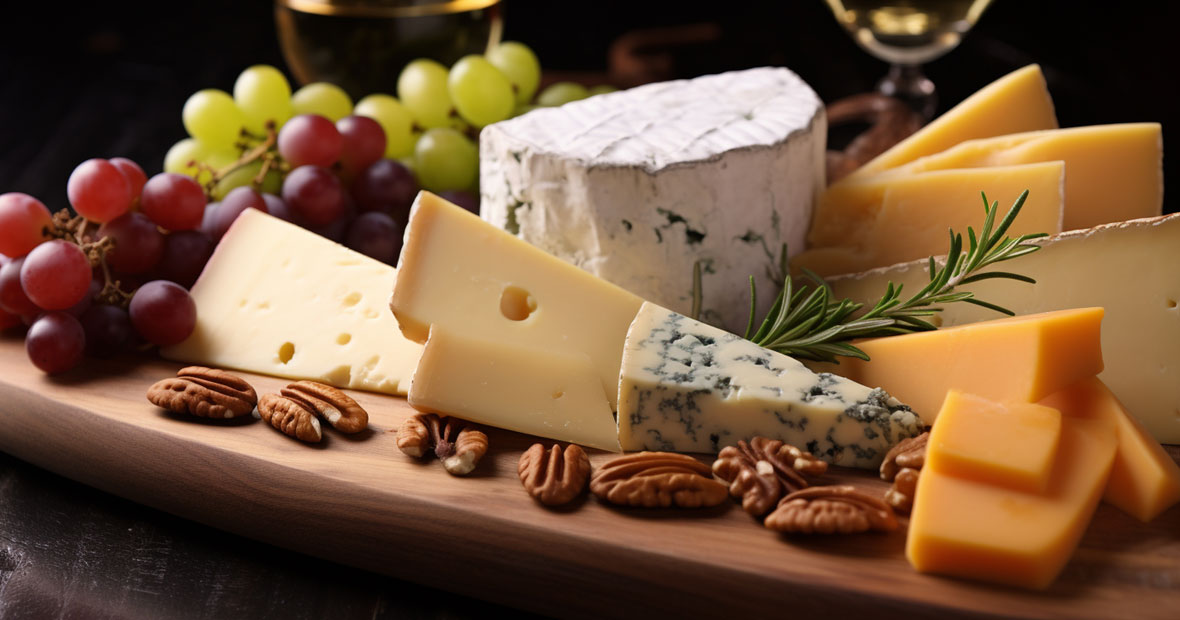
People have been exploring cheese and wine pairing ever since 5500 BCE, just 500 years after the first wines emerged in ancient civilizations. This magical combination has evolved into a prized culinary tradition that explores the adventure of taste. The right cheese can uncover the hidden notes in a complicated bouquet, and the right bouquet can do the same for a fine cheese. The cheese and wine romance has lasted thousands of years because it unlocks flavours you’d never find on their own. Our best cheese platter will give you precisely that kind of discovery, so let’s explore.
Learning the Basics
If you’re starting your cheese and wine journey right from the beginning, don’t feel intimidated. Food pairing is designed to give you enjoyment, and not to make you look like the most sophisticated culinary marvel in the room. If it tastes good, it’s a good pairing for you, but you’ll have a more comprehensive experience if you learn a few simple guidelines:
- Match intensities if you don't want your pairings will overpower the other. Delicate cheeses work well with light-bodied whites, while bold, aged cheddar works better with the robust taste of a Cabernet Sauvignon.
- Play with opposites: A pungent cheese like camembert is beautifully balanced by a sweet wine. You might even pair it with a light Muscadet.
- Try several different wines with firm, nutty cheeses. Gruyere and Emmental are the great pretenders of the cheese realm. They will transform into a thousand things depending on your wine choice.
- Regional wines and cheeses often go together, so try pairing champagne and Brie or Chablis with goat cheese from the Burgundy region.
If you’re a beginner, start with a wine and cheese pairing chart, but be willing to experiment. Find all about cheeseboard kits online !
Moving Beyond Legalistic Pairings
Pairing wine and cheese should be fun, so don’t let purism or fear get in your way. Adventures are much better when you’re adventurous, so experiment. Try the “wrong” wines with the “wrong” cheeses. Find out what wine and cheese platter ideas can do for one another. Make foodie “mistakes” because every palette has its own quirks.
Don’t assume your foodie options are only good if they’re expensive. This exercise doesn’t have to cost you much. While it might be worthwhile to invest in a beautifully aged merlot, there are plenty of pocket-friendly, low-tannin wines that won’t clear your bank account. If you shop by regions that are known for their fabulous cheeses and wines, you’ll find your foodie experience far more affordable. Go to the birthplace of your chosen wine or cheese. If you’re adding cured meats and jams to your experience, do the same. Regions like Burgundy and Napa Valley earn reputations for a reason. They’re legitimately good at what they do.
Explore Harmony and Contrast
There are two ways to handle food pairing: By connecting complementary flavours or by building contrasts. Companion flavours will achieve a harmonious experience, while contrasts will bring out the best in both your cheese and wine. Once you know which of those two options you enjoy, you can start adding fruit, jams, and cured meats to your tastings. They can often build a bridge between a duo that wouldn’t work on its own. You’ll be inventing your own fruit and cheese platter ideas in no time.
As with wine and cheese, your meats and fruits will enhance your experience if you play with harmony and contrast. A soft mascarpone, for example, is delicious with crunchy nuts or crisp biscotti. A semi-soft provolone offsets apples and grilled vegetables gorgeously. Similarly, mild meats offset mild wines and sweet ingredients offset salty ones.
It’s easy enough to find the best wine and cheese pairings online, but sometimes it’s better to give those pairing charts a little berth. Your journey might reward you far more if you understand what makes pairings work because then you’ll know which rules to break… and yes, you really should break rules—as frequently and enthusiastically as possible.